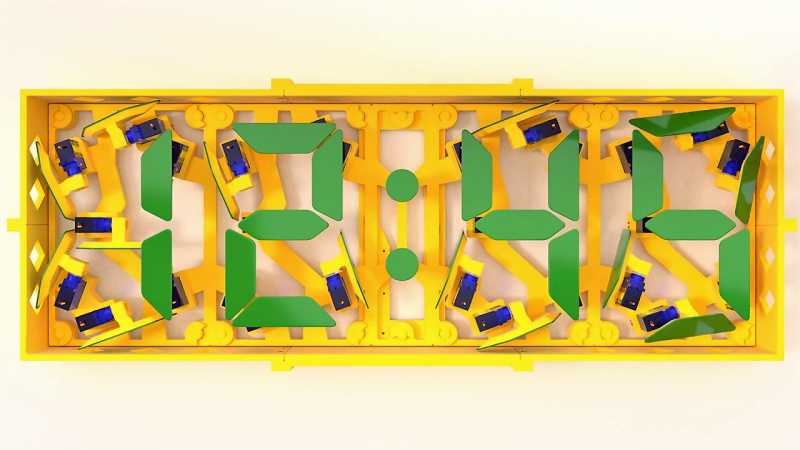A digital clock based on seven-segment displays? Not exciting. A digital clock with seven-segment displays that’s really big and can be read across a football field? That’s a little more interesting. A large format digital clock that uses electromechanical seven-segment displays? Now that’s something to check out.
This clock comes to us by way of [Otvinta] and is a nice example of what you can do with 3D-printing and a little imagination. Each segment of the display is connected to a small hobby servo which can flip it 90°. Mounted in a printed plastic frame, the segments are flipped in and out of view as needed to compose the numerals needed to display the time. The 28 servos need two Pololu controller boards, which talk to a Raspberry Pi running Windows IoT, an interesting design choice that we don’t often see. You’d think that 28 servos clattering back and forth might be intolerable, but the video below shows that the display is actually pretty quiet. We’d love to see this printed all in black with white segment faces, or even a fluorescent plastic; how cool would that look under UV light?
We’re not saying this is the only seven-segment servo clock we’ve seen, but it is a pretty slick build. And of course there’s more than one way to use servos to tell the time.
Welcome back to the tip business, [baldpower]!
















paint the plastic black. That yellow makes it difficult to watch.
Neat though.
I recognized their logo watermark from YouTube, all their 3d printed stuff they showcase is that green and yellow. I dunno if their biggest Patreon support is the Green Bay Packers or what…. but it’s how they seem to brand themselves with the yellow and green 3D prints.
Yea. It’s an interesting phenomenon. Think about all the red plastic used by Ivan Miranda in YouTube. https://www.youtube.com/channel/UCF3cDM_hQMtIEJvEW1BZugg
It should be noted that makers and designers can be divided into those who have a sense of what color to use aesthetically and those who do not. (or don’t care) Some people just want to make stuff that works and don’t care what color things are so they get in a rut when it comes to color. Also with 3d printing changing color means changing plastic with often less than subtle print settings differences. People who are focused on making things work would choose a color and stick with it unless compelled to do otherwise. :-) Why add one more variable to an already complex equation? :-)
I made this clock, although did the frame in black and the pastels in gold/yellow.
The Pi + .net source is truly hateful. Takes age to boot and is really unreliable. (Crashes)
I converted mine to Arduino, and it boots instantly, turns itself off @ 6pm and starts @ 8am, also does a little “flourish” every hours.
Haha an digital clock made with analog servos ;)
Do you suggest they use digital servos?
Didn’t I just see this on Instructables?
Or maybe it was Thingiverse…
I often look at these… want to build them… then realize how loud they would be, therefore making them not practical for day to day use.
If you build it yourself you can run the servos much slower, make them quieter.
Practical day to day use? I think you’ve got the wrong target demographic entirely
Would have looked better in black and white.
yeah the yellow background make it difficult to read, but nice project, not truly silent loll
I like this. For a totally different approach, here’s another 7-segment counter I saw recently:
https://youtu.be/la30_i-NDFM
This build wins.
That one could be built with one servo per digit.